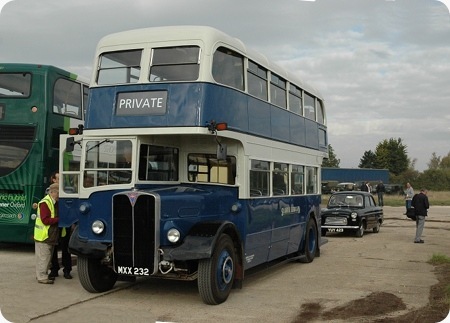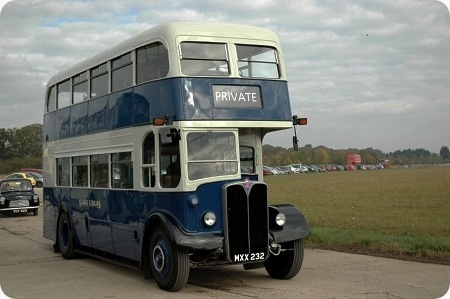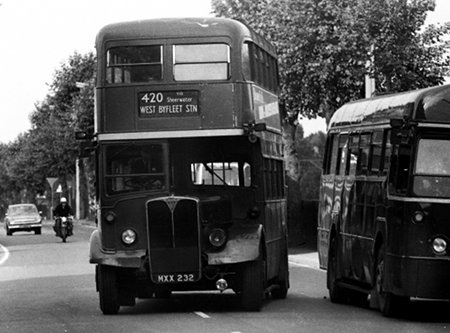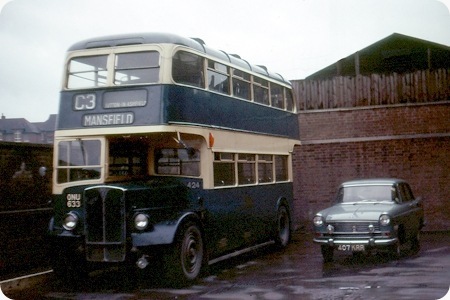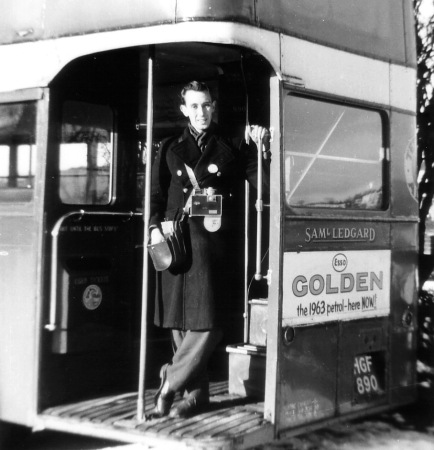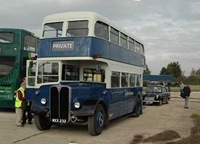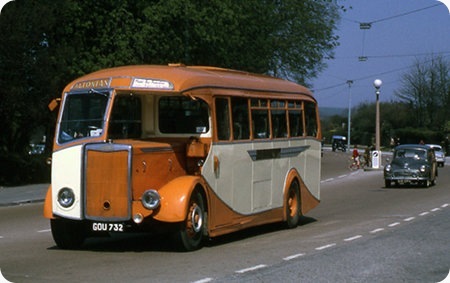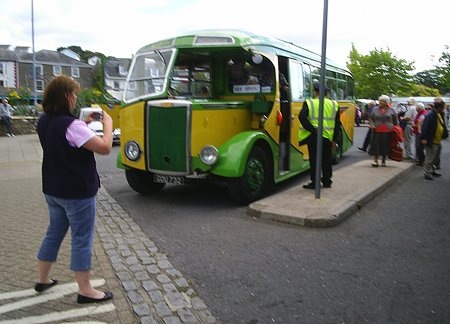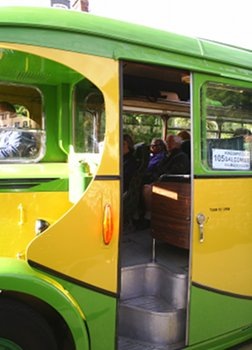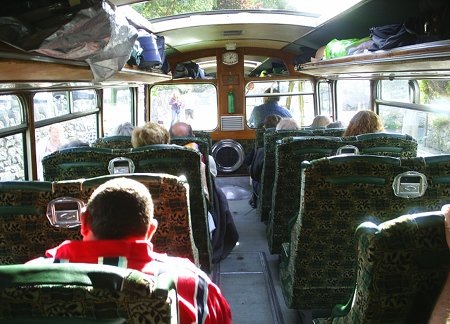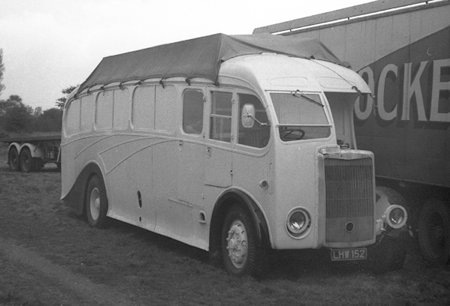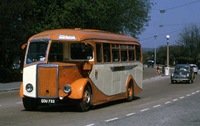Browns Blue Bus – Daimler CWA6 – GYE 64
Browns Blue Bus Service
1945
Daimler CWA6
Duple H27/26R
In the 14th. edition of London Transport ABC, a photo of D 179 was shown as belonging to Brown’s Blue Bus Service of Ibstock (Leics.) On 10th January 1958, therefore, I went to Leicester with T. Brown and we saw and rode on such a D. Foolishly, however, we neglected to note the registration number and later found that while we had ridden on a D to Markfield, thinking it to be 179, it actually was not.
To refine the search, on the 1st. February, 1958, I went again to Leicester, with T. Houghton and we saw five more D’s, excluding the one I had seen before, now known to be D169. Their LT fleet nos. had been D19. 161, 165, 169, 179 and 74 which is pictured above. We rode on D74 to Ibstock where Brown’s Blue had recently taken over the garage of Victory Coaches Ltd. who owned a couple of fine AECs. The Daimler in the background is ex-East Kent, and a newish Leyland coach is on the right.
I have a dozen or so photos of (mostly) withdrawn buses, which I’m glad I’ve kept; I have often wondered if there might be a forum which gathers these things in for posterity – your website may be it!
I hope this contribution may be of interest to you chaps.
Photograph and Copy contributed by Victor Brumby
A full list of Daimler codes can be seen here.
27/10/11 – 07:36
Thank you, Victor for a super photo and text. I envy you. I remember seeing a D at Hinckley (I think) about the time you were actually riding on them. As an eleven year-old Leeds lad, I always associated blue utility Daimlers with Sammy Ledgard, and I couldn’t quite come to terms with the uncanny similarity (in my eyes). In the mists of time, one forgets that it was not just the ubiquitous Midland Red that served Leicestershire – fascinating as the MR fleet was at that time. If only I had been born a few years earlier so I could have ridden and photographed these D’s (and whatever else Brown’s Blue could offer) on routes which, even today, are unknown to me.
Paul Haywood
27/10/11 – 14:06
Is that Hylton and Dawsons Leyland Royal Tiger in the background?
Philip Carlton
01/11/11 – 11:43
Coming from Yorkshire like Paul, I too was fascinated by the "Browns Blue" post and superb photo, especially as I now live in Loughborough.
I would love to learn more about the firm, its fleet and routes, if anyone feels like "writing in".
Anything to do with London Daimlers, and a "Ledgardian" approach has to be totally absorbing!
John Whitaker
01/11/11 – 14:39
Browns Blue was quite a substantial operator which originated in 1923. Ultimately their operating area covered Loughborough, Whitwick, Ashby, Coalville, Ibstock, Hinckley and Leicester. They sold out to Midland Red in 1963 by which time the fleet totalled thirty nine vehicles. Apart from three Daimler double deckers bought new after the war, the general policy seemed to be second hand deckers for service work and most coaches bought new, these included some Dennis Lancets which later received Yeates full front bodies. There were six ex-London Daimlers and also one from Southport. In 1963, nine early post war RT’s were purchased and also some Regent III’s from Sheffield and Devon General. An unusual feature was that most of their double deckers were fitted with platform doors by the company, including all of the LT D’s. From photographic evidence, it appears that it was usual for them to have one double decker on service with a coach as a duplicate. There were three depots at the time of sale, at Markfield, Ibstock and Leicester. The unusual name arose from the fact that the firm was founded by Mr Laurence Brown and his vehicles were blue!
Chris Barker
02/11/11 – 09:32
Thanks Chris for the Browns Blue information. I believe they had at least one "HGF" D type, making the Ledgard similarity stronger. Did the Ds last into the 1960s, or was their demise before the RT intake, and take over?
Also, did they ever run into Shepshed, or is the Leicester to Shepshed route of thorough Midland Red origin?
Dare I ask if you or any other enthusiast, has any notion of a fleet list?!
Thanks again
John Whitaker
02/11/11 – 13:29
The Daimlers were all Duple bodied, EWM 372 ex Southport and GYE 64, HGC 288/292/296, HGF 806 and GLX 905. I was wrong about the RT’s, these arrived in 1958 and gradually replaced the Daimlers which had all gone by 1959 except the CVD6’s bought new, 2 Brush and 1 Roberts which lasted a year or so longer. The fleet was almost all AEC and Bedford by the takeover. I don’t believe they reached Shepshed but apparently reached Loughborough from Copt Oak via Nanpantan although this is not mentioned in lists so perhaps was occasional. The nearest point to Shepshed would have been Whitwick. The new replacement Midland Red services were numbered C70 – C72 and C80 – C89 with gaps, also 665/666 670, 677, 686/688 and 694. I’m afraid these numbers mean nothing to me however!
Chris Barker
03/11/11 – 06:29
Many thanks again Chris for the detailed info on "Brown’s Blue"
John Whitaker
06/11/11 – 17:11
Paul, John and Chris – thank you indeed for your speedy recognition of the ex-London utility Daimlers and a cornucopia of additional data on Mr. Brown’s Blues!
Victor Brumby
22/01/12 – 06:59
Brown’s Blue is still a famous name to those who lived in NW Leics in the 50’s and early 60’s. The service went past my house in Newbold Verdon (10 miles West of Leicester). One route served the (then) mining villages such as Bagworth and Ellistown – terminating in the main square in Coalville. We travelled on a weekend to see family and I always sat in the ‘pretend’ drivers seat upstairs at the front.
Neil Brearley
09/05/12 – 09:17
I worked as a conductor for the midland red Coalville garage in 1968/9 as a summer student.The midland red Markfield garage had just closed and their drivers and conductors moved to Coalville most of these fine gentlemen had been Browns Blue men so I got to hear lots of stories about how good a company Browns Blue was. I remember them operating several ancient AEC double deckers from London Transport.
Wayne Robinson
09/05/12 – 19:12
It’s interesting to note that D’s 161, 165, 169 & 179 started life as Green Line vehicles, based at Romford Garage and used on routes from Aldgate to Romford and other places in Essex. There were also Summer services from Baker Street to Whipsnade Zoo, which I travelled on one year. By 1950, they were considered worn out from traversing the punishing East End cobbles and put into store. The staff at Merton Garage, who had all the other ‘early’ D’s, heard about them and eventually insisted on having them, despite union objections, because it enabled older buses to be withdrawn. It turned out that they were actually in fine fettle and ran alongside their red compatriots for a few months, before being re-painted red. I recall them in green at Morden, where I lived, adding colour to the bus scene. Their lives were no shorter than the other D’s, which says much for their rugged construction, more usually acknowledged in the austerity Guy Arabs.
Like John Whitaker, I love all things ‘D’, especially as I lived in the middle of LT’s ‘Daimlerland’ They, plus the pre-war RT’s, made the area unique for many years.
D74, above, looks, bodily, in good condition, with not trace of sag on the waistline. It was overhauled by LT, in 1951, which would have helped.
Chris Hebbron
09/08/12 – 07:28
Interesting to find this forum as I am the grandson of Lawrence Daniel Brown, the founder of Browns Blue. The business started out from Markfield in a long garage at the side of our detached house. I remember it well and the story goes that Grandad had a lorry for transporting goods during the week and at weekends swapped the back end for a shed type structure with a row of wooden seats and he used to ferry people from Leicester to Bradgate Park at weekends. I spent many an early morning travelling to and from the pits to ferry the miners around Stanton and Merry Lees etc.
Nigel Brown
30/10/12 – 06:04
It was truly wonderful reading about Browns Blue busses, my Uncle Reg Brown used to talk about them when i visited him. Many thanks
Lesley Sherriff
30/10/12 – 06:05
Just read all the comments about Browns Blue. I had just entered a piece about my journeys on Browns Blue to and from Charnwood School on another site. South Charnwood as it was then. I was eleven then and all their vehicles were saloon type single deck buses. We seemed to have two drivers on our school service. One we knew as Baz and the other was ‘misery’ because he never smiled. This was about 1938 just as WWII was about to start. I travelled on Browns Blue during the war until I left school at 14 and started work At D. Byford hosiery firm on Blackbird Road in Leicester. I joined up in 1944 – 1948
John Swan
30/10/12 – 15:08
Can I direct anybody interested in finding out more about Brown’s Blue to the recently published history of the company by Mick Gamble, published by Leicester Transport Heritage Trust? It’s not cheap by any means, but in hardback at 212 pages with some great colour pictures, I guess that reflects a limited print of 500 (mine, sourced through MDS Books, is no 104…). After the company history, Appendices cover subsequent events, garages/staff, personnel, remnants/prsent day, and fleet-list. Highly-recommended.
Philip Rushworth
15/12/12 – 07:37
I am sat here in not so Sunny, but warmer than England SPAIN.
I am writing a piece to say in Church tomorrow, and I wanted to find the name of the Bus company I used to catch with my Mum to go shopping from Newbold Verdon to Coalville in 1956 when I was 9 years old.
I know now it was Browns Blue we used to get the Bus outside the Dragon pub in Dragon Lane.
The Beauty of the Old Browns Blue was if you could see the Bus coming up from the Recky you could run and be at the Bus stop at the Dragon before the bus got there.
We used to get the bus every day when I went to Ibstock Sec Modern they never let us down not even in the bad winter of 1962.
David Isaacs
23/01/13 – 15:46
I was pleased to find your site as I am the eldest grand-daughter of Laurence Daniel Brown and I have many childhood memories of playing around the garage with my brothers and sisters (not allowed these days of course!) we knew all the drivers and conductors, and they all kept an eye on us we were known as little beggars if I remember rightly!
Cheryl Halse
11/03/13 – 07:23
I am a just retired heavy truck mechanic but I remember Brown,s Blue buses very well.In 1954 we lived in Heather right opposite the school Browns used to run a school run bringing the kiddies from Normanton-Le-Heath to Heather primary school. My mam would take me to the bus stop I was 4 years old then and put me on the bus give the conductor 1 penny and ask him to put me off at my Gran Lawrences’s house at 3 Station road. The conductor I remember well was Mr Briers he made sure I always sat in the front seat next to the driver the bus used was usually the Bedford "O" type the driving area was painted brown And I remember the engine cover had a small guard at the rear protecting the gear lever which "rattled" all the time. It made my day to sit and watch the driver another chap who worked on this route was Alf Andrews from Ibstock. Everyone was friendly everyone knew everyone if you were running for the bus they would always stop and pick you up. This service through Ibstock and Heather ran through to Ashby de la Zouch I reckon it ran 2 services a day and picked the kids up in the afternoon when school finished the bus stopped opposite the school for the pick up.
It was a very sad day for Ibstock and the surrounding villages when Brown,s Blue finished very sad.
In later years when I trained as a truck mechanic with A. Fletcher & Son on Station Road Ibstock I worked with a chap who had worked at Browns for many years his name was Tom Powell he lived in Congerstone and he drove a lovely 2 tone blue Vauxhall Cresta the one with the rear wings tom was a good work mate.
After Browns had finished Mr Briers son Roy started a bus company called Reliant Coaches they were predominately blue in colour they ran for many years after taking over Joe Rudin,s garage at Strawberry Villa on the Melbourne Road Ibstock one or two of the chaps who worked for Roy also were old Brown’s Men Roy ran a good outfit good buses all AEC Happy days. We shall not see the likes of again.
Tony Lawrence
12/03/13 – 06:30
Lovely childhood memories, Tony. Thx for sharing them with us – as you say, those days are gone. Pity!
Chris Hebbron
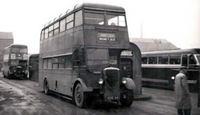 Vehicle reminder shot for this posting
Vehicle reminder shot for this posting
02/06/13 – 06:30
My father drove for Browns Blue as did my grandad sadly both have past away my father rests in Groby church yard very close to Laurence the founder. How fitting this is so as the firm was like a family, when I visit I thank Laurence with a prayer thanks for the memories rest in peace all.
Keith Partner
Quick links to the - Comments Page - Contact Page - Home Page

